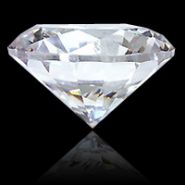Diamond Education
DIAMOND GUIDE
THE 4 C’S
Cut
While nature determines a diamond’s clarity, carat weight and color, an expert cutter is required to unlock the fire with a perfectly proportioned cut. A diamond is cut and polished with an exact number of facets. It’s proportions are derived by mathematical calculation. A well-cut diamond, regardless of its shape offers the greatest brilliance and value. Light will reflect from one facet to another dispersing through the stone.
Ideal Proportions |
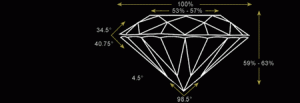 |
Ideal cutThe facet junctions forming the table will noticeably bow in. Small table – full crown clean, even girdle. |
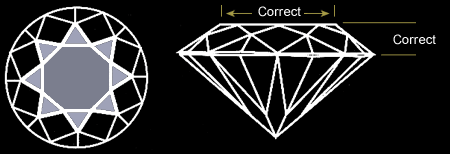 |
Spread cutThe table outline will appear to bow out. Large table – flat crown. Thick, irregular girdle. |
 |
ShallowDiamonds that are cut too shallow “leak” light and will be less brilliant. |
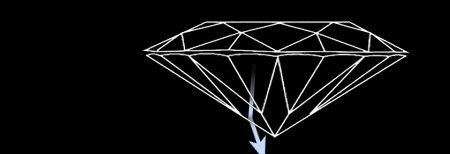 |
Too deepDiamonds that are cut too deep “leak” light and will be less brilliant. |
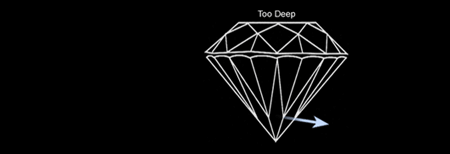 |
DIAMOND SHAPES
Diamonds can be cut into different shapes. Choosing a diamond shape is a matter of personal preference. All shapes are beautiful if they are cut well, including Marquise, Oval Pear, Radiant, Heart and Emerald. But all fancy shapes have inherent difference in the physics of light.
Round BrilliantThe most popular shape is the Round Brilliant Cut which commands more of a premium per carat because more of the rough is cut away to form the round shape. |
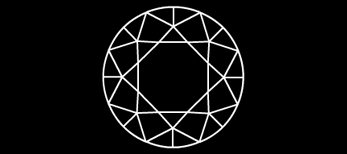 |
MarquiseThe Marquise Cut is a regal, elongated shape with both ends tapered. When choosing an elongated diamond be careful to avoid the ‘bow-tie’ effect. Also, with a marquis cut the length to width ratio should be considered |
 |
PearAlthough this shape is most often used in pendants, an elongated pear shape can create a slimming effect on the finger. The preferred length-to-width ration is between 1.45 and 1.75 |
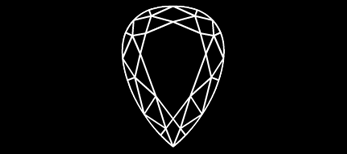 |
OvalAn oval diamond has brilliance that is similar to a round diamond. The oval shaped diamonds can accentuate slender, long fingers. The length-to-width ratio is important and will determine the diamond’s outline. Ratios between 1.33 and 1.66 are most traditionally accepted for ovals. |
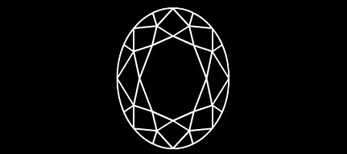 |
EmeraldThe emerald cut diamond is among the most classic of diamond shapes. Inclusions are more visible in the emerald cut. Because of their design, rectangular cut diamonds require more weight to be directed toward the diamond’s depth to maximize brilliance. Depth percentages of 70% to 78% are not uncommon. |
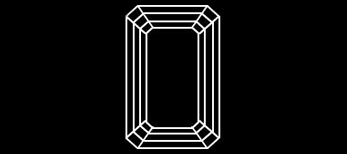 |
RadiantThe radiant cut is a beautiful combination of the classic emerald cut and the sparkle of the round brilliant. Because of their design, rectangular cut diamonds require more weight to be directed toward the diamond’s depth to maximize brilliance. Depth percentage of 70% to 78% are not uncommon. |
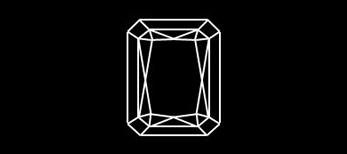 |
PrincessThis shape is the perfect choice if you prefer a square or rectangular outline but want the brilliance of a round. Because of their design, square cut diamonds require more weight to be directed toward the diamonds depth to maximize brilliance. Depth percentages of 70% to 78% are not uncommon. |
 |
Colour and Colourless
Fancy colour diamonds in well defined colours including red, pink, blue, green and canary yellow, are highly prized and particularly rare, but in traditional diamonds the best colour is no colour at all. These diamonds are graded starting at D for colourless diamonds and continuing through the alphabet to Z, for yellowish ones. While many diamonds appear colourless, they may actually have subtle yellow -brown tones in colour grades of M to P.
DEFColorless |
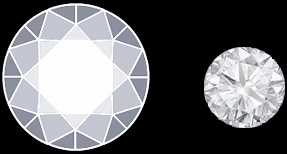 |
GHIJNear colorless |
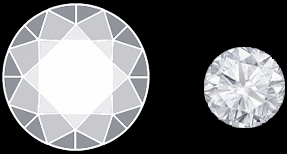 |
KLMFaint yellow |
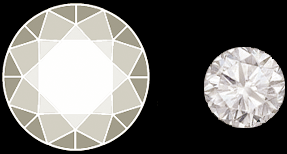 |
NOPQRVery light yellow |
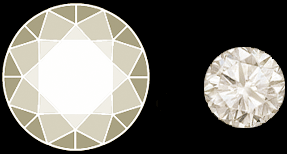 |
Carat and Carat Weight
A carat is equivalent to one fifth of a gram (.007ounces) and is divided into 100 points. All other characteristics being equal, the larger the diamond, the more rare, the higher the price per carat. For example, a two carat diamond will cost far more than twice the price of a one carat diamond of the same quality.
This chart illustrates how diamonds of different carat weights look in comparison to an average hand. This is for illustration purposes only. Once you have determined what cut, color, and clarity grade you are looking for in a diamond, it is easy to determine the carat weight of diamond that will fit within your budget. Our experts at Donald Haack Diamonds and Fine Gems can educate you in all the 4 C’s and help you make that all important choice in a quality diamond.
1/4 Carat |
4mm |
1/2 Carat |
5.2mm |
3/4 Carat |
5.9mm |
1 Carat |
6.5mm |
1.5 Carat |
7.4mm |
2 Carat |
8mm |
2.5 Carat |
8.8mm |
3 Carat |
9.4mm |
3.5 Carat |
9.7mm |
4 Carat |
10.4mm |
4.5 Carat |
10.8mm |
5 Carat |
11.2mm |
Clarity
Clarity refers to the presence of absence of inclusion found in the diamond. The fewer and smaller the inclusions, the less likely they will interfere with the passage of light through the diamond. Grading for clarity ranges from Flawless to Imperfect. At Donald Haack Diamonds and Fine Gems you will be able to examine the clarity of your diamond under binocular magnification.
Internally Flawless – IFFree from internal blemishes. No inclusions visible under 10X magnification. Very rare and beautiful diamonds. |
 |
Very Very Slightly Included – VVS (Minute)Very difficult to see flaws or inclusion under 10X magnification. This is an excellent quality diamond. |
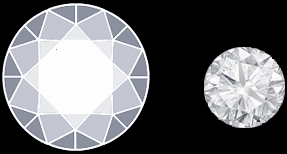 |
Very Slightly Included – VS (Minor)Inclusions are not typically visible and difficult to locate under a 10X magnification. Less expensive than the VVS and IF. |
 |
Slightly Included – SI (Noticeable)Inclusions are easy to locate and very visible under 10X magnification and may be visible with the unaided eye. Still a good diamond value. |
 |
Included – I (Obvious)Medium or large inclusions or external blemishes which are usually obvious to the naked eye under favorable lighting conditions. |
 |
DIAMONDS IN NATURE
From carbon to diamond
Diamond has several unique and extreme properties. It is the hardest, the least compressible and the best thermal conductor among all known materials. Moreover it is chemically inert to most acids and alkalis. These exceptional properties make diamond valuable both intrinsically as a gem, for usage in industrial applications, and as a tool for scientists concerned with unraveling Earth processes. Although diamond is decidedly rare, it actually consists of one of the most common building blocks of the material world: carbon.
Diamond is made up solely of carbon atoms, which form short, stable and strong bonds among them. What makes diamond so hard is its three-dimensional crystalline structure of regularly arranged carbon atoms. Diamond is the stable form of carbon at high pressure and temperature conditions. At a temperature of 1325°C, a pressure of 50000 kg/cm2 is required to grow diamond. This extreme pressure corresponds to the weight of the Eiffel tower (9441 tons) on your hand. Without this pressure, graphite instead of diamond forms.
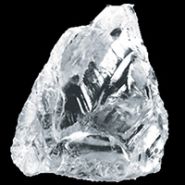
A long journey
Scientists believe that the Earth is more than 4.5 billion years old while the oldest modern humans are just less than 160,000 years old. Having this time span in mind it is interesting to note that the oldest diamonds we know date from 3 billion years ago.
In most cases, the diamonds are stored deep in the earth for considerable times, sometimes for billions of years, before reaching the Earth’s surface. Academics agree that gem diamonds are formed deep in the Earth, and more in particular at depths of about 150 to 200 kilometers below the surface.
Thanks to volcanic activity, the precious mineral is brought to daylight. The diamond-containing magma that crystallizes by cooling is known as kimberlite or lamproite. An important diamond discovery includes the presence of about 1 carat of diamond in a ton of the mining ore kimberlite or lamproite.
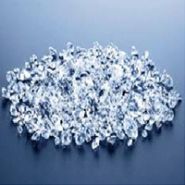
Iron-hard diamond
Diamond receives the highest possible score of 10 on the Mohs scale, which measures hardness in gemstones. This means that diamond scratches every other material without being scratched itself. No acid or base (alkali) can corrode diamond.
Diamond repels water but attracts fat. For this reason, you should avoid touching a polished diamond with your fingers. Diamond is a good conductor of heat. Thus, when it is not in contact with a source of heat, it always feels cold in.
